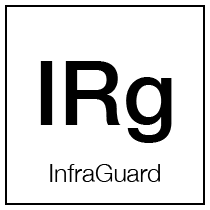The risks and safety of avobenzone in skincare
Misinformation about sunscreen is common. Don't let myths deter you from using them to protect your skin.

One of the more effective ways to take care of your skin’s health and maintain a youthful appearance is to protect it from the sun. Sunscreens are the most effective way to do this.
There are two types of sunscreen, chemical and physical. Physical sunscreens such as zinc oxide often congest your skin, leave a white cast and reduce the lasting power of make-up. This is where chemical sunscreens have become useful.
One of these chemical sunscreens is avobenzone. Avobenzone works by absorbing UV rays protecting the skin from severe sunburns and melanoma and helps to shield the skin from damage to healthy skin cells and collagen. Like most sunscreens, avobenzone works by absorbing the UV rays and converting them to an energy that is less damaging to the skin, heat.
Avobenzone and similar ingredients are often called chemical sunscreens, they can also be called organic sunscreens. Avobenzone is highly effective at protecting the skin against UVA rays; however, it does break down when it is exposed to the sun. This breakdown is minimized by the addition of stabilizers such as octocrylene. Most chemical sunscreen formulations will include more than one sunscreen ingredient. This is due to both improving the spectrum of the sunscreen and helping to stabilize its effectiveness.

There are two categories of sunscreens: physical and chemical. Avobenzone falls into the chemical-based sunscreen category. Understanding the difference is essential when determining which product is right for you.
-----
PHYSICAL SUNSCREEN
Physical sunscreens work by absorbing the UV rays from the sun and transferring it into heat.
Physical sunscreens are often described as working by reflecting the UV rays from the skin. This isn’t technically true; while physical sunscreens reflect UV rays, they only reflect about 10%. The rest of the UV rays are absorbed and converted into heat, precisely like chemical sunscreens. The heat produced from this action is negligible and doesn’t damage the skin.
These formulations rely on ingredients such as zinc oxide and titanium dioxide to provide this protection. Physical sunscreens create a barrier between the skin and the sun and aren’t absorbed into the skin. They are generally broad-spectrum, protecting against both UVA and UVB rays. Physical sunscreens are designed to sit on top of the skin, so they often leave a white cast on the skin when used correctly.
----
CHEMICAL SUNSCREEN
Chemical sunscreens are absorbed into the skin and absorb the sun’s harmful rays before they can penetrate deep enough to cause damage to the skin.
Often chemical sunscreens are used in combination with another chemical sunscreen to provide broad-spectrum protection. In the case of avobenzone, it is commonly used in conjunction with UVB blocking ingredients as it works best in preventing damage from UVA rays.
Also, both physical and chemical sunscreens will often include ingredients such as vitamin C or E to protect against damage from free radicals.

Skin exposure to the UVA portion of the sun's ultraviolet spectrum (320–400 nm) is strongly linked with immunosuppression and premature skin aging. Short UVA wavelengths also contribute significantly to sunburn risk.
Although many available ingredients filter UVB rays effectively, fewer cover the UVA spectrum.
Avobenzone provides superior protection through a large portion of the UVA spectrum, including most of the UVA-1 spectrum.
Avobenzone is the most effective UVA sunscreen active used today in sunscreen products with broad-spectrum protection. It is the only globally available chemical sunscreen agent that provides proper UVA protection. Avobenzone displays a peak of absorption around 360 nm but absorbs broadly across the entire UVA spectrum. However, if not properly formulated, avobenzone can undergo chemical degradation during exposure to ultraviolet radiation (UVR). Today, many special photostabilizing ingredients plus formulation techniques are available to ensure that avobenzone remains photostable even during prolonged UVR exposures.

Absolutely. The FDA has found avobenzone to be safe in sunscreen formulations. At Dermal Health Science, we follow a strictly restricted ingredient list that goes beyond industry standards.

The recent concerns have been around whether or not Avebenzone will be absorbed into the bloodstream and disrupt hormones in our body. The FDA has cleared sunscreens containing avobenzone as safe for sun protection, and dermatologists still recommend SPF products containing the ingredient. Still, in 2019, the FDA revealed that "a growing body of data has suggested that the transdermal absorption of some sunscreen active ingredients is greater than previously thought." This meant ingredients such as oxybenzone and avobenzene were being studied further to investigate whether this could have long-term effects on the endocrine system, including hormonal and reproductive disruption.
We know that sounds scary, but putting all the data and findings in context is important to prevent "fear-mongering". First of all, the FDA’s review of sunscreens is a good thing! This means that the FDA is taking steps to ensure sunscreen's continued safety and efficacy and to clear up confusion around sunscreen labels. While the FDA asks for more data, it does not say the ingredients are unsafe. It does not ask the public to stop using sunscreens containing these ingredients. In fact, the study authors and the FDA concluded that people should continue to use sunscreen to protect themselves from the sun.
Let's look at the presented evidence thus far: The majority of studies suggest the ingredient's absorption into the bloodstream is not significant enough to cause harm at the concentrations approved by the FDA. Researchers have pointed out in more recent studies that "just because an ingredient is absorbed into the bloodstream does not mean that it is harmful or unsafe."
Of all the ingredients the FDA is investigating, oxybenzone has received the worst press because of concerns that it may act as what is known as a hormone disrupter. A hormone disruptor is a chemical that has the ability to cross cell membranes and may interfere with your body's natural hormone production. However, there has been no conclusive evidence that oxybenzone is harmful to humans. Organizations that have raised concerns about oxybenzone typically cite studies done in rats, where the rats were actually fed oxybenzone. It would take an individual 277 years of sunscreen use to achieve the equivalent systemic dose that produced effects in these rat studies, according to a 2017 study in the Journal of the American Academy of Dermatology.
Bottom line - Should you wear Sunscreens with Avobenzone?
Current research indicates that Avobenzone does not cause hormone problems unless you are actively eating it or injecting it into your bloodstream. Since no independent, peer-reviewed, published clinical trial data exist to indicate that avobenzone is harmful, and the FDA has substantiated no data, the choice to wear sunscreens containing the ingredient comes down to personal preference.
Sunscreens with avobenzone help prevent sun damage and, therefore, protect you from sunburn, premature aging, and skin cancer. Chemical sunscreens also tend to be more cosmetically elegant without a white cast or residue, and since the best SPF is the one you wear daily, this is valid reasoning for choosing a chemical formula. Still, if you're concerned about potential endocrine disruption or want a more environmentally friendly option, go for a physical or mineral sunscreen.
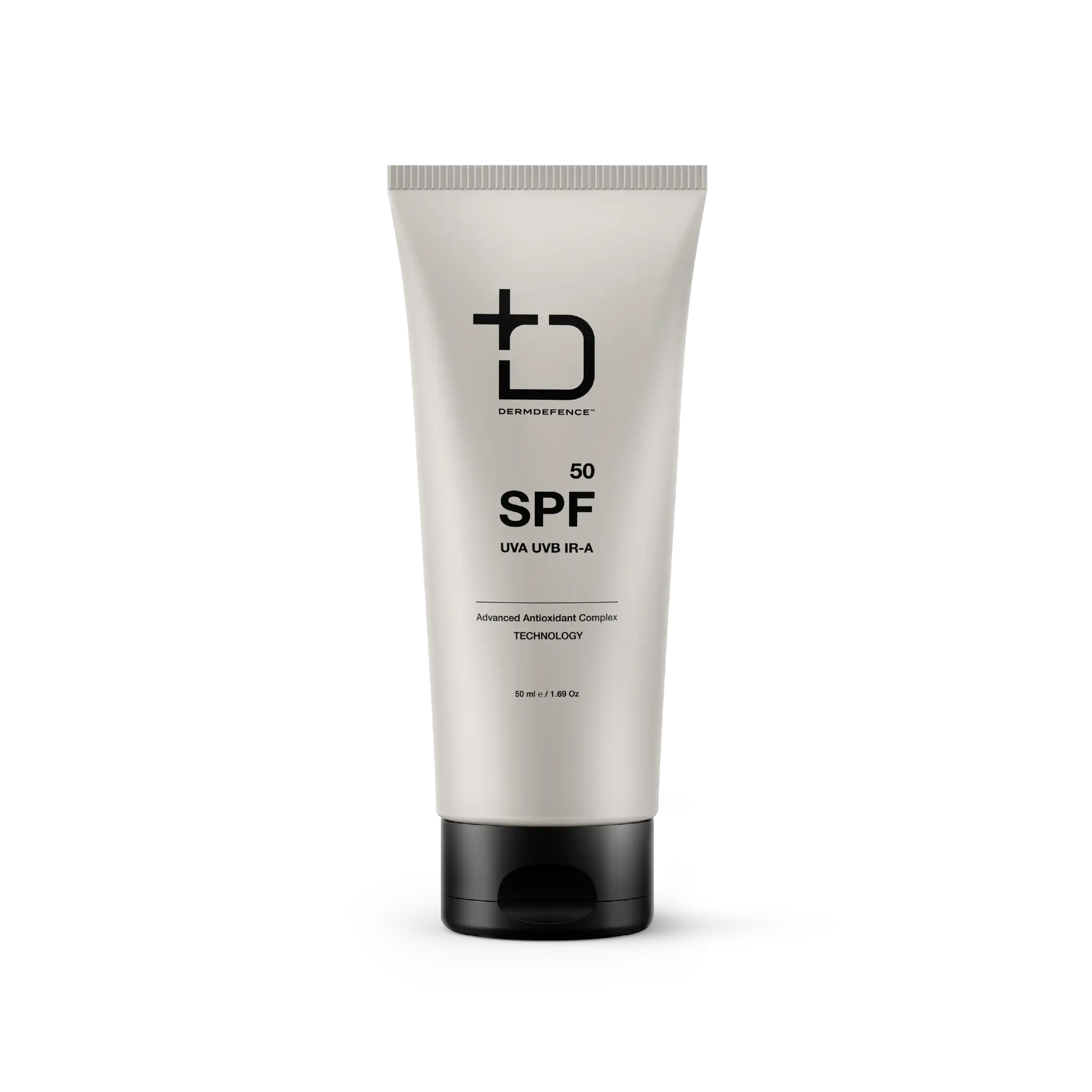
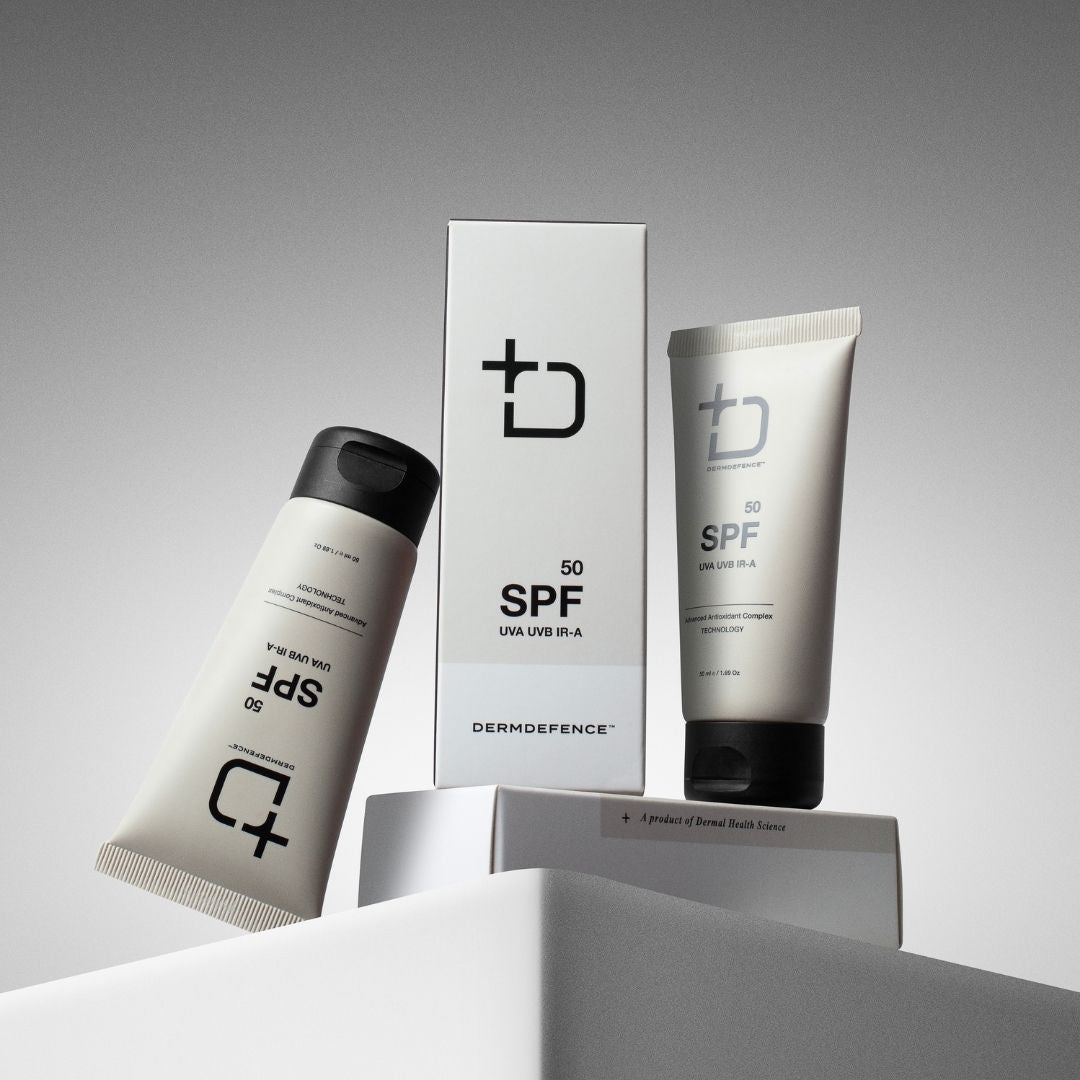




Pay interest-free installments from R 142.25 with various payment gateways selected at checkout.
SIZE: 50 mL

Antioxidant

anti-aging

DNA repair

sun protection

Moisturizing
A pioneering sunscreen that provides comprehensive protection against harmful UVA, UVB, infrared rays, and blue light, while supporting your skin's health and resilience. This unique sunscreen counteracts UV radiation-induced free radicals and diminishes UV-induced redness, thus effectively battling signs of aging.
Dermdefence SPF 50 is fragrance-free, anti-comedogenic, lightweight, and easy to apply It absorbs quickly without leaving any white residue. Dermdefence SPF 50 doubles as a smooth primer for effortless makeup application. Dermdefence SPF 50 provides unparalleled sun protection that nurtures your skin's needs while enhancing its radiance and vitality.
Coenzyme Q10
CoQ10 is a potent ingredient that offers comprehensive skin health and appearance benefits. Its role in energy production and its antioxidant and anti-aging properties make it invaluable for photoprotection, anti-aging, and overall skin vitality. Its incorporation into DermExcel sunscreen represents a holistic approach to skin health, addressing protective and restorative needs.
Physiological Impact
- Skin Barrier Enhancement: CoQ10 contributes to the strength and health of the skin barrier, improving its ability to retain moisture and protect against external irritants and pollutants.
- Skin Repair and Regeneration: It supports the skin's natural ability to repair itself and regenerate, maintaining a healthy, youthful appearance. This is particularly beneficial in mature skin, where natural levels of CoQ10 may be depleted.
Pharmacological Advantages
- Anti-Aging Effects: CoQ10's antioxidant properties contribute to its anti-aging effects. By reducing oxidative stress, it helps to minimize the visible signs of aging, such as wrinkles and fine lines.
- Photoprotection: It enhances the skin's defense against photoaging caused by exposure to UV rays. CoQ10 helps to mitigate the degradation of collagen and elastin, proteins essential for maintaining skin elasticity and firmness.
Biochemical Benefits
- Cellular Energy Production: CoQ10 plays a crucial role in the mitochondrial electron transport chain, which is essential for the production of ATP, the primary energy currency of the cell. This function is vital for maintaining the health and vitality of skin cells.
- Antioxidant Properties: It acts as a lipophilic antioxidant, neutralizing free radicals and preventing oxidative damage to cell membranes, proteins, and DNA. This is particularly important in the skin, which is frequently exposed to oxidative stress from environmental factors like UV radiation.
Vitamin E
The fat-soluble Vitamin E's benefits in maintaining skin health and appearance are well-acknowledged in both cosmetic and clinical dermatology. Comprising a group of eight compounds, including four tocopherols and four tocotrienols, Vitamin E is known for its role in protecting cell membranes from oxidative damage.
Vitamin E is celebrated in skincare for its ability to neutralize free radicals caused by environmental stressors such as UV radiation and pollution. These free radicals can lead to premature skin aging, making Vitamin E a valuable ingredient in anti-aging skincare products. Its antioxidant action helps to protect the skin from damage, reduce the appearance of wrinkles, and improve skin texture and tone.
Additionally, Vitamin E is known for its moisturizing benefits. It helps to strengthen the skin barrier, reduce moisture loss, and keep the skin hydrated and supple. This makes it especially beneficial for dry and damaged skin.
Vitamin E also has anti-inflammatory properties, making it beneficial in soothing and calming irritated skin. This has implications for conditions such as dermatitis and acne, where inflammation plays a key role.
Physiological Effects
- Antioxidant Protection: Vitamin E neutralizes harmful free radicals in the skin, preventing oxidative stress and damage caused by environmental factors like UV radiation and pollution.
- Moisturization: It has moisturizing properties, helping to improve skin hydration and alleviate dryness.
- Wound Healing: Vitamin E may assist in the skin's healing process, although its efficacy in wound healing is still a subject of research.
- Photoprotection: While not a sunscreen, it can provide some degree of photoprotection by strengthening the skin's defense against UV-induced damage.
- Anti-Inflammatory Effects: It helps reduce skin inflammation and is beneficial in managing conditions like eczema and psoriasis.
Managing Dermatological Conditions
- Skin Aging: Its antioxidant properties make it useful in anti-aging skincare products to protect against free radical damage and improve skin appearance.
- Dry Skin Conditions: Vitamin E's moisturizing effects are beneficial in treating dry skin and improving overall skin texture.
- Inflammatory Skin Diseases: It can be helpful in soothing inflammatory skin conditions like eczema and psoriasis.
- Sun Protection and Repair: Vitamin E is included in sunscreens and after-sun products for its ability to mitigate sun damage.
- Scar Treatment: Some studies suggest Vitamin E may help reduce the appearance of scars, although evidence is mixed.
References
- Thiele, J. J., Hsieh, S. N., & Ekanayake-Mudiyanselage, S. (1998). Vitamin E: Critical Review of Its Current Use in Cosmetic and Clinical Dermatology. Dermatologic Surgery, 24(7), 805–813.
- Ratz-Łyko, A., & Arct, J. (2016). Anti-inflammatory and anti-aging properties of active skin care ingredients. Journal of Clinical and Aesthetic Dermatology, 9(9), 36–40.
- Keen, M. A., & Hassan, I. (2016). Vitamin E in dermatology. Indian Dermatology Online Journal.
- Ekanayake-Mudiyanselage, S., & Thiele, J. (2007). Vitamin E in human skin: Organ-specific physiology and considerations for its use in dermatology. Molecular Aspects of Medicine.
- Nachbar, F., & Korting, H. C. (1995). The role of vitamin E in normal and damaged skin. Journal of Molecular Medicine.
Broad Spectrum Filters
Tinosorb® M and Tinosorb® S represent sophisticated advancements in sun protection technology.
Tinosorb® M
- Biochemical Action: A unique UV filter due to its ability to function through absorption, reflection, and scattering of UV rays.
- Physiological Impact: The triple-action mechanism of Tinosorb® M offers comprehensive sun protection. By mitigating the penetration of both UVA and UVB rays, it significantly reduces the risk of DNA damage, photoaging, and carcinogenesis. Its ability to remain on the skin's surface reduces systemic exposure, making it a safer option with minimal potential for irritation or allergic reactions.
Tinosorb® S
- Biochemical Action: A broad-spectrum UV filter with a molecular structure that effectively absorbs both UVA and UVB rays. Additionally, it enhances the photostability of other UV filters, making the sunscreen formulation more effective over time.
- Physiological Impact: By providing extensive UVA and UVB protection, Tinosorb® S plays a crucial role in preventing short-term sun damage like sunburn and long-term risks such as skin aging and skin cancer. Its photostability ensures sustained protection during sun exposure, and its compatibility with other UV filters means it can be used to formulate sunscreens that are both effective and suitable for sensitive skin.
Sunscreen
Using sunscreen is a fundamental aspect of skin care and preventive dermatology. It's essential for reducing the risk of skin cancers and photoaging and maintaining overall skin health in the face of constant exposure to UV radiation.
Sunscreen is a vital skincare product designed to protect the skin from the harmful effects of ultraviolet (UV) radiation from the sun. Two primary types of UV radiation affect the skin: UVA and UVB. UVA rays penetrate deep into the skin and are primarily responsible for aging and long-term skin damage, whereas UVB rays cause sunburn and play a key role in developing skin cancer.
Sunscreen products work by either absorbing, reflecting, or scattering sunlight. They contain chemical compounds that absorb UV radiation and convert it into a small amount of heat or physical compounds (like zinc oxide or titanium dioxide) that act as a physical barrier, reflecting UV light away from the skin.
The effectiveness of sunscreen is measured by its Sun Protection Factor (SPF). SPF indicates how well the sunscreen protects against UVB rays. For example, an SPF of 30 means it would take 30 times longer for your skin to burn than without sunscreen. However, it's important to note that no sunscreen can block 100% UV rays.
Regular use of sunscreen with an SPF of at least 30 can reduce the risk of skin cancer, prevent sunburn, and slow down the skin's aging process.
Managing Dermatological Conditions
- Prevention of Sunburn: Sunscreen protects the skin from UVB rays, which cause sunburn. This reduces the immediate risk of skin damage and discomfort.
- Skin Cancer Prevention: Regular use of sunscreen significantly lowers the risk of developing various types of skin cancer, especially melanoma, squamous cell carcinoma, and basal cell carcinoma.
- Prevention of Photoaging: Sunscreen also shields the skin from UVA rays, which penetrate deeper into the skin and are primarily responsible for photoaging, including wrinkles, leathery skin, and sunspots.
- Protection Against Photosensitivity: Sunscreen helps prevent flare-ups triggered by sun exposure for individuals with photosensitive skin conditions like lupus or rosacea.
- Hyperpigmentation and Melasma: It aids in preventing and managing hyperpigmentation and melasma, conditions exacerbated by sun exposure.
- General Skin Health: Sunscreen helps maintain overall skin health and integrity by protecting the skin from UV damage.
References
- Burnett, M. E., & Wang, S. Q. (2011). Current sunscreen controversies: a critical review. Photodermatology, Photoimmunology & Photomedicine.
- Green, A. C., et al. (2011). Reduced melanoma after regular sunscreen use: randomized trial follow-up. Journal of Clinical Oncology.
- Hughes, M. C. B., et al. (2013). Sunscreen and Prevention of Skin Aging: A Randomized Trial. Annals of Internal Medicine.
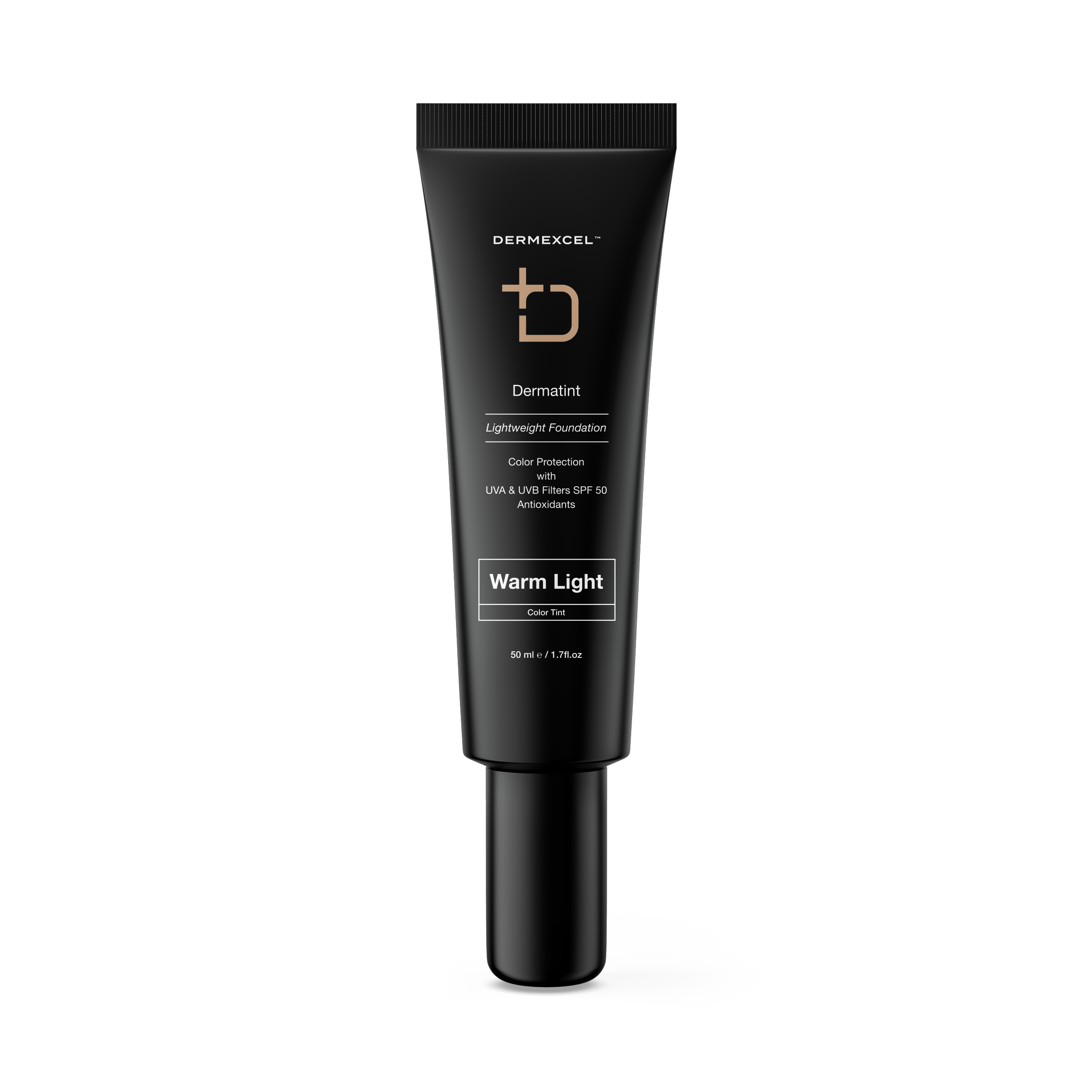
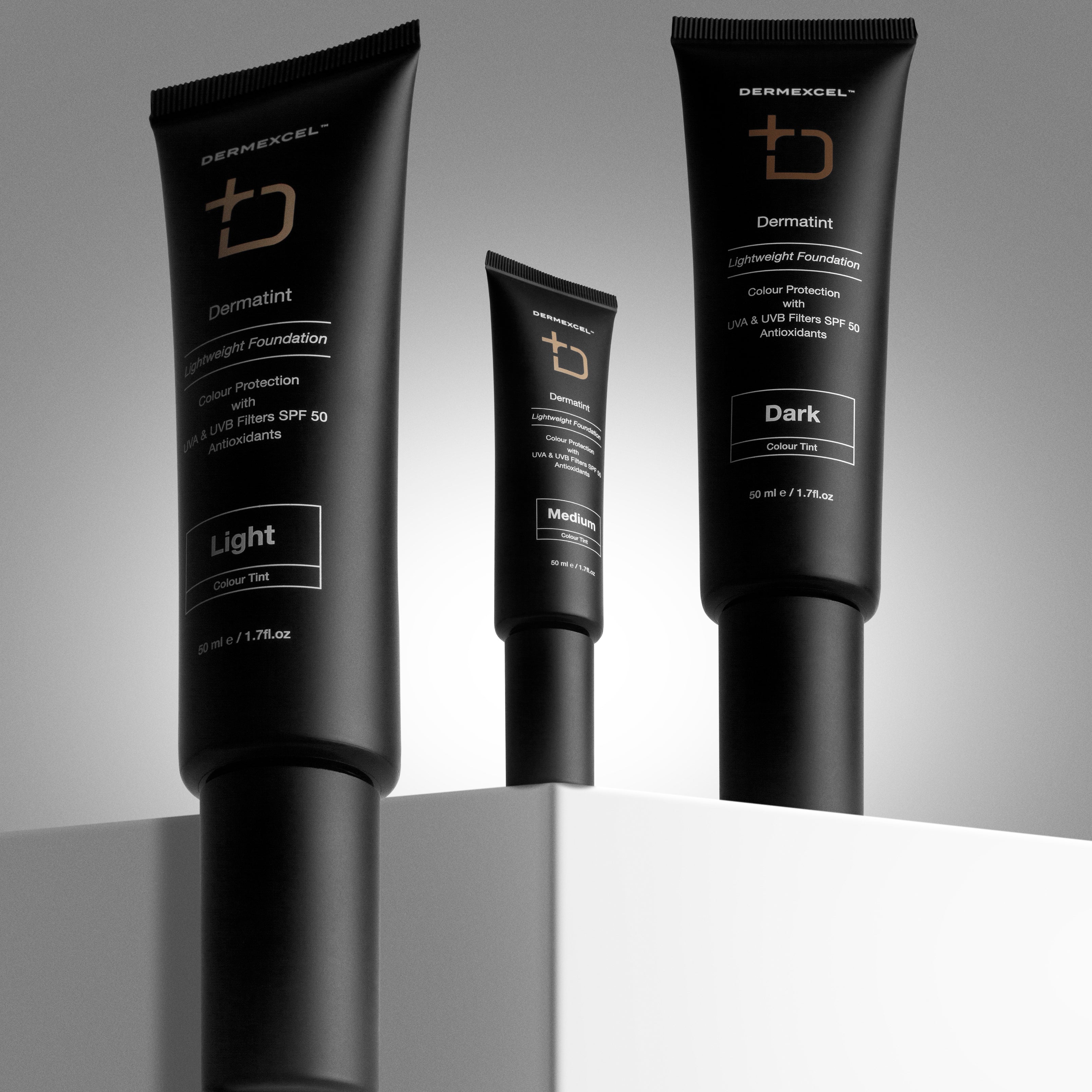
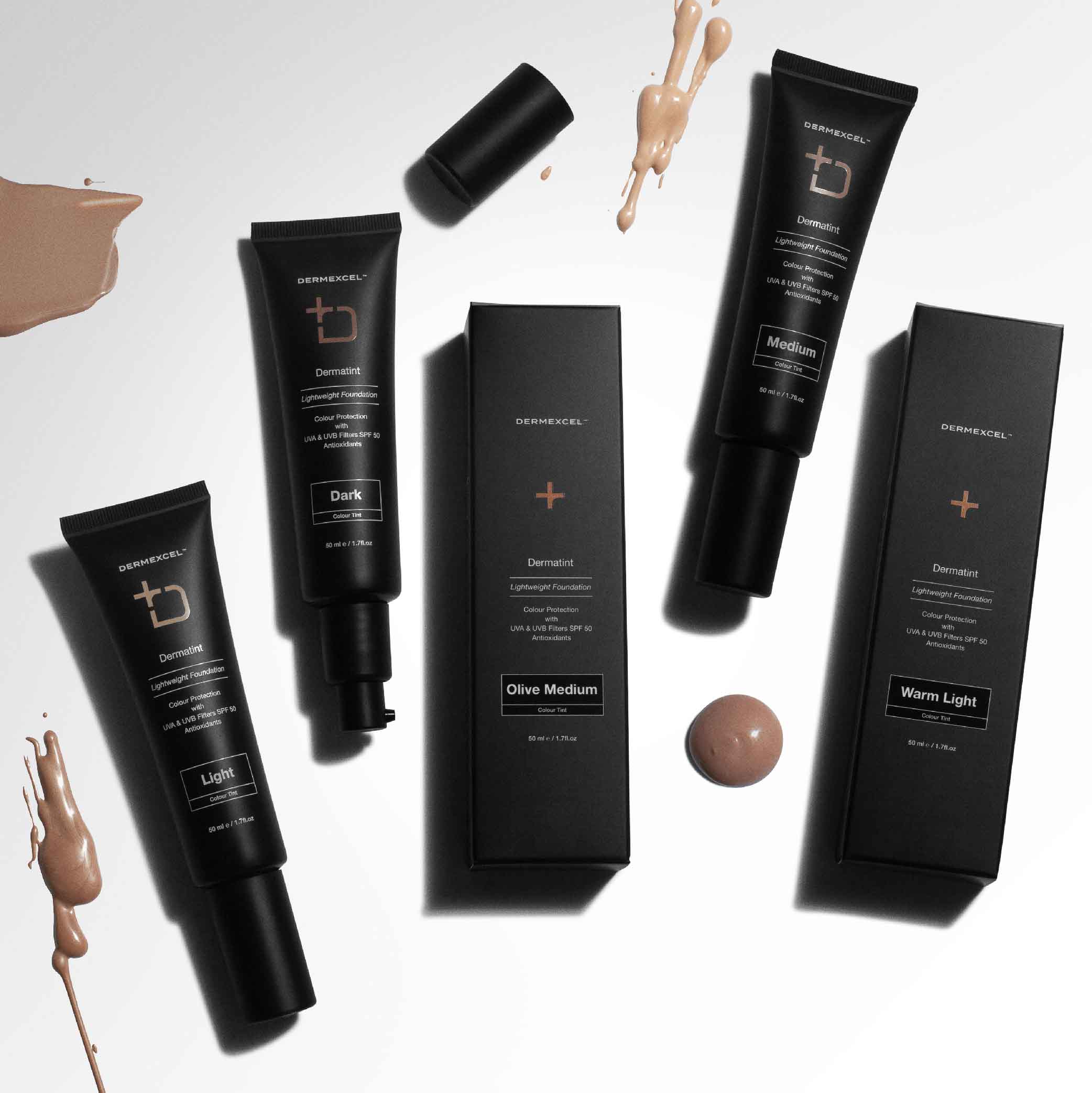
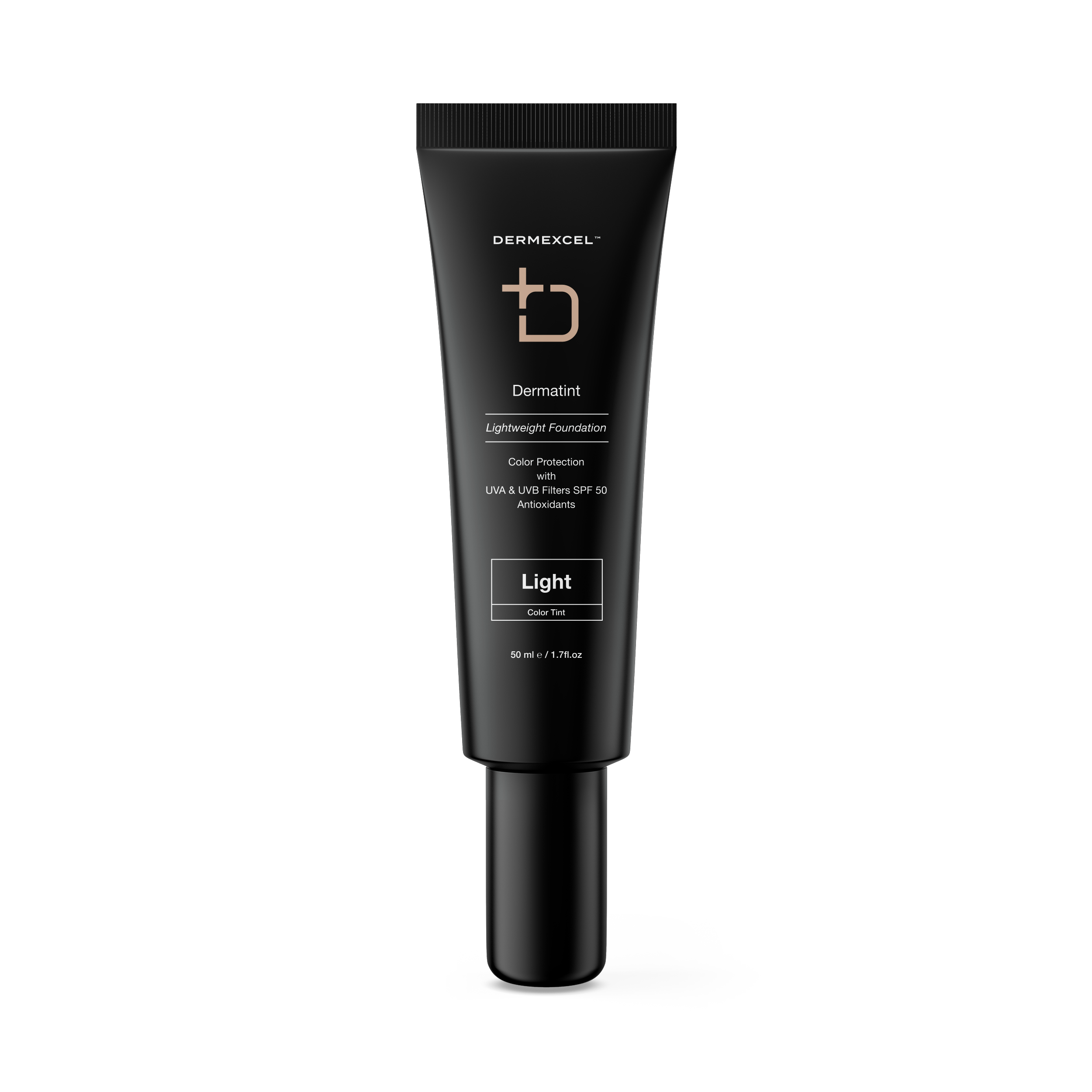
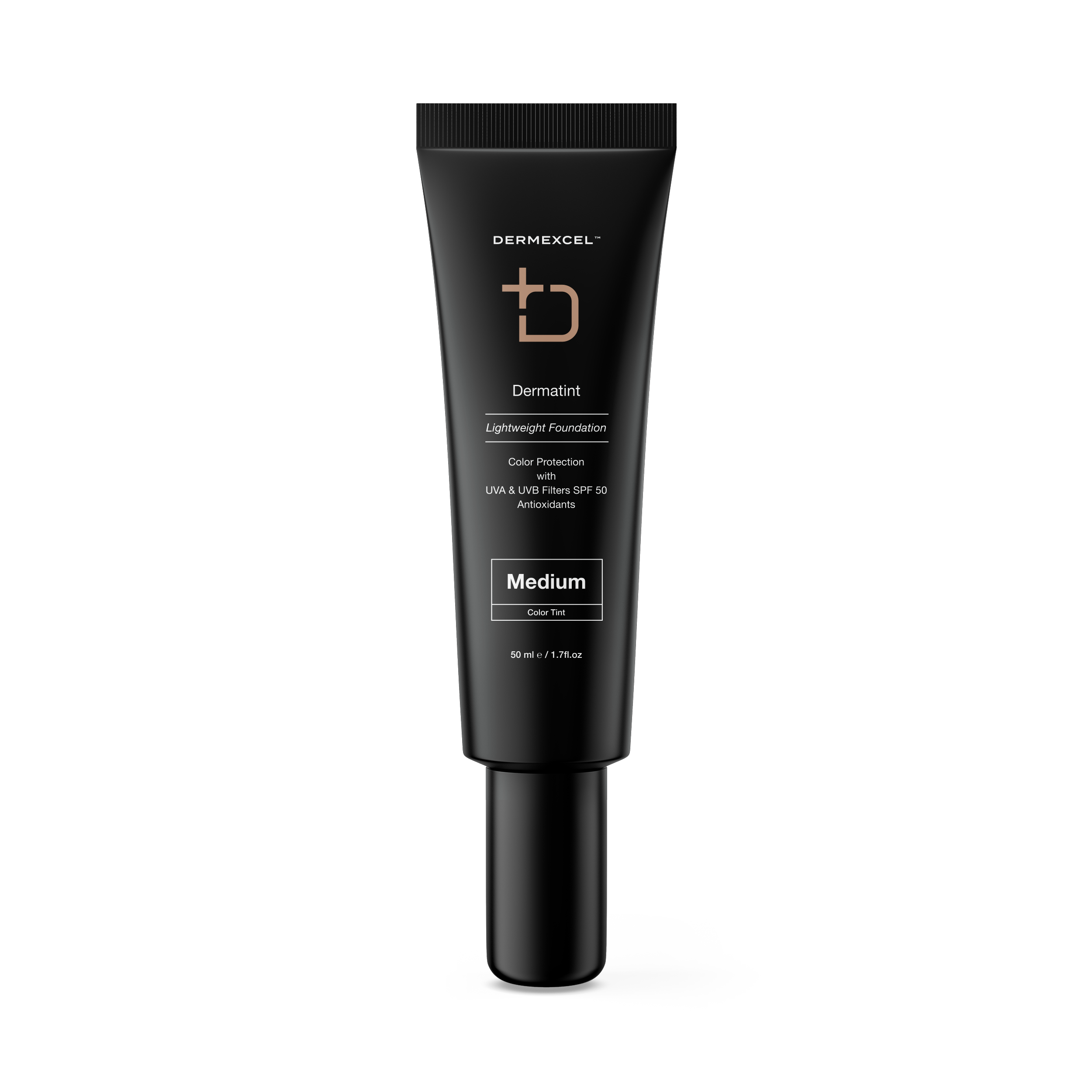
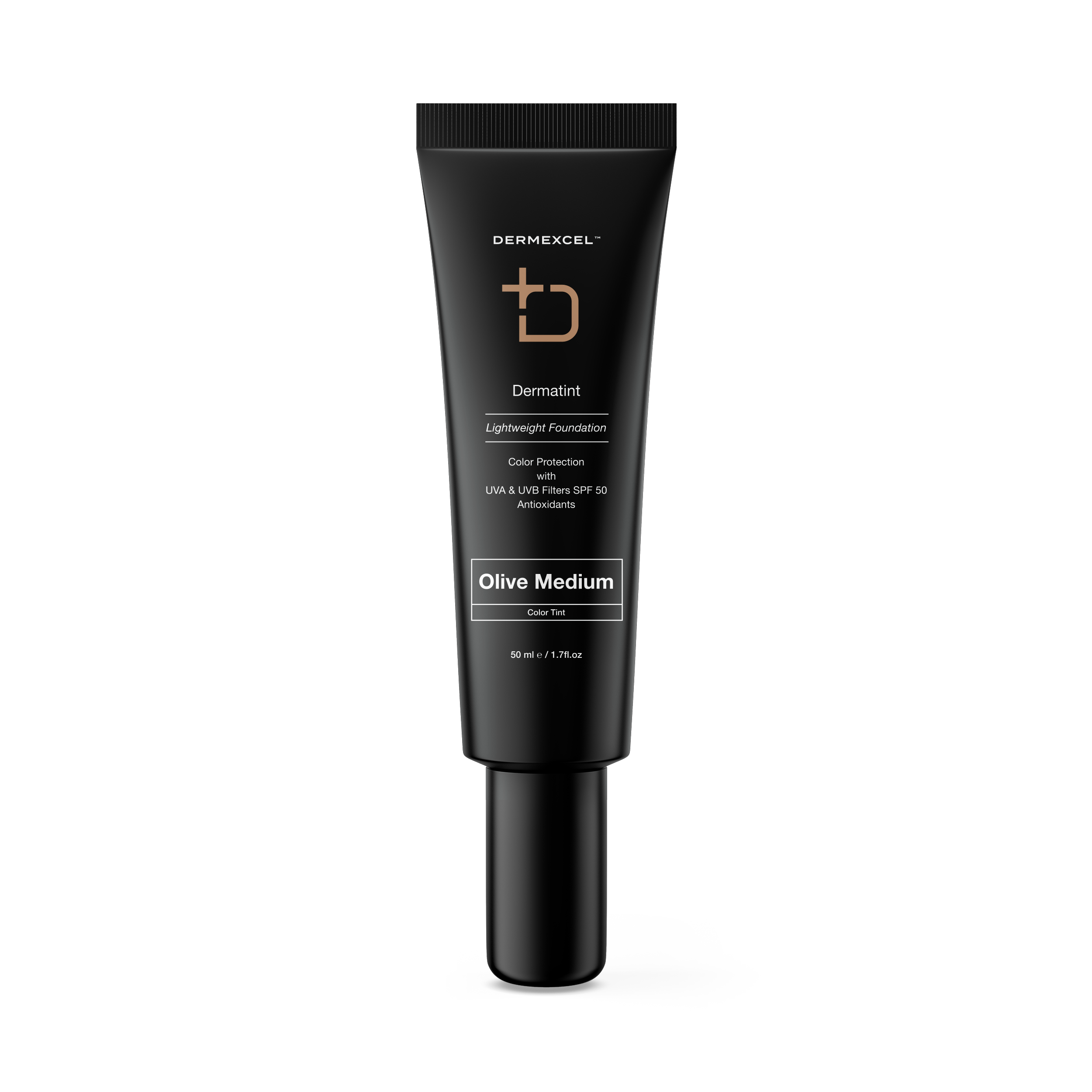

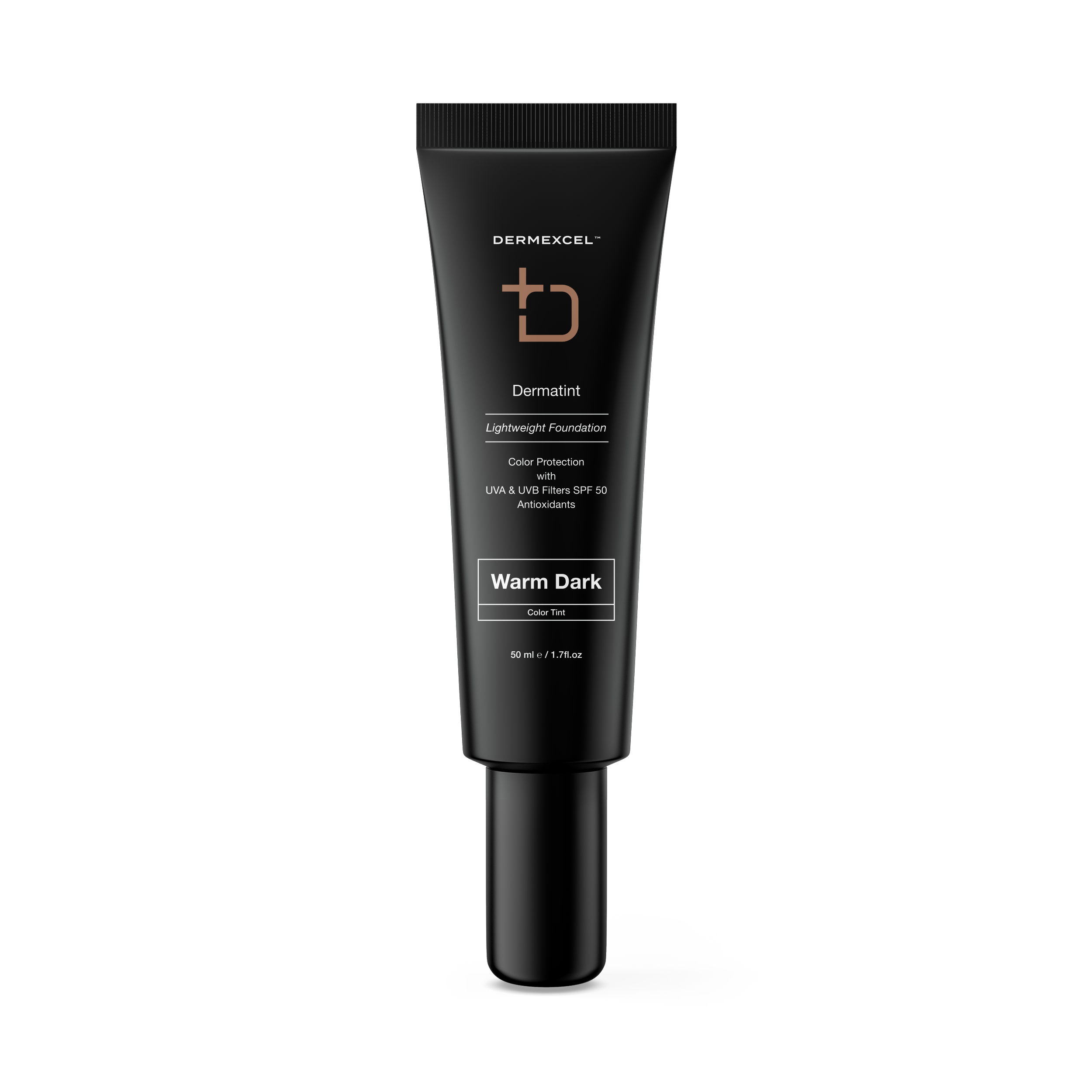




Lightweight Foundation
Pay interest-free installments from R 224.75 with various payment gateways selected at checkout.

Color Correct

Anti-Aging

Antioxidant

DNA Protection

sun protection
Dermatint SPF 50 blends high-level UV protection with concealment and color correction, crafted through advanced R&D to merge mineral and chemical sunscreens using triple UV filter technology for robust environmental protection.
Incorporating Infraguard®, Dermatint counters free radicals and blue light, preserving collagen and skin vitality. Dermatint SPF 50 moisturizes and soothes, offering more than just sun safety. This multifaceted sunscreen not only protects but also nourishes, making it a superior skincare choice for comprehensive protection and skin health enhancement.
Infraguard™
Infraguard™ is a novel and powerful antioxidant powerhouse designed to protect the skin from the potentially harmful effects of electromagnetic radiation, specifically from 5G networks, blue light, and other environmental stressors. It shields the skin against oxidative stress and inflammation, prevents premature aging, and maintains overall health.
Infraguard® is a multifunctional ingredient that extends beyond traditional sun protection. It addresses the broader spectrum of light-induced skin damage and oxidative stress, provides DNA protection, and offers anti-aging benefits. Its inclusion in the DermExcel sunscreens represents an advanced step in comprehensive skin care, targeting UV rays and the often-overlooked infrared and blue light, ensuring a more holistic approach to maintaining skin health and appearance.
Physiological Effects
- Protection Against Blue Light and Infrared (IR) Radiation: Infraguard is formulated to shield the skin from the harmful effects of blue light and IR radiation, which can lead to premature skin aging and damage.
- Antioxidant Properties: It has strong antioxidant capabilities, helping to neutralize free radicals induced by environmental stressors such as pollution, IR, and blue light.
- Anti-Aging Benefits: By protecting against IR radiation and mitigating oxidative stress, Infraguard helps to prevent signs of aging like wrinkles and loss of skin elasticity.
- Skin Barrier Protection: Infraguard strengthens the skin's natural barrier, enhancing its resilience against environmental factors.
- DNA Protection: Infraguard™ aids in shielding the DNA in skin cells from damage caused by environmental aggressors. This is crucial in maintaining the integrity of skin cells and preventing mutations that can lead to skin aging and other skin-related issues.
Managing Dermatological Conditions
- Preventing Photoaging: Infraguard's ability to protect against IR and blue light makes it beneficial in preventing photoaging, a key concern in modern dermatology. Infrared light can penetrate deeper into the skin than UV rays, potentially leading to increased collagen degradation and skin laxity. Infraguard® helps mitigate these effects.
- Combatting Environmental Stressors: Its antioxidant properties protect the skin from various environmental pollutants and stressors.
- Supporting Skin Health: Infraguard contributes to overall skin health by improving the skin's barrier function and providing antioxidant support.
- Suitability for Diverse Skin Conditions: Given its protective and anti-aging properties, Infraguard is suitable for use in various dermatological conditions, especially environmental damage and aging.
References
- Kappler, Katharina et al. "Development of an in Vitro Assay to Evaluate the Biological Impact of 5G Technology on Human Skin. Journal of Cosmetics, Dermatological Sciences and Applications, 2022, vol. 12, pp. 100-108. DOI: 10.4236/jcdsa.2022.122009.
- Extensive references cited within the research article including studies on 5G technology, health effects, and skin biology.
UVB Filters
Uvinul® T 150 and Uvinul® MC 80 offer superior UVB protection, high photostability and very good skin compatibility.
Uvinul® T 150
- High UVB Absorption: Uvinul® T 150 is known for its exceptionally high UVB absorption. It is one of the most efficient UVB filters on a per weight basis, meaning less of it is required to achieve the same level of protection as other filters.
- Photostability: This compound is highly photostable, meaning it doesn't degrade easily when exposed to sunlight. This property is crucial for maintaining consistent UV protection over time.
- Water Resistance: Uvinul® T 150 improve the water resistance of our sunscreen, beneficial for when you have swimming or outdoor activities.
- Low Irritation Potential: It is generally well-tolerated by the skin, with a lower risk of irritation or sensitization compared to other UVB filters.
Uvinul® MC 80
- Efficacy: With an extensive and impressive safety and efficacy history, Uvinul® MC 80 is highly effective in protecting the skin from UVB rays, which are primarily responsible for sunburn and can contribute to skin cancer.
- Elegance: Uvinul® MC 80 have a fantastic texture, leaving no white cast.
UVA Filters
Uvinul® A Plus is a highly effective, photostable, and skin-friendly UVA filter.
Advantages of Uvinul® A Plus Over Other UVA Filters
- High Efficiency: It has a high UVA absorption capacity, which means that smaller quantities are needed to achieve desired levels of UVA protection.
- Broad-Spectrum UVA Protection and Enhanced Sunscreen Efficacy: Uvinul® A Plus provides strong protection against UVA rays, which are responsible for deeper skin damage including premature aging, wrinkles, and increasing the risk of certain types of skin cancer. By effectively absorbing UVA rays, it complements UVB filters in the formulation to offer broad-spectrum protection, crucial for comprehensive sun care.
- Excellent Photostability: Compared to other UVA filters, Uvinul® A Plus is more photostable, reducing the risk of degradation and loss of efficacy when exposed to sunlight.
- Skin Compatibility: It is generally well-tolerated by the skin, with a lower incidence of irritation or allergic reactions compared to other UVA filters.
- Elegance: Uvinul® A Plus is pleasant to use and apply evenly - without leaving a white cast on your skin!
Broad Spectrum Filters
Tinosorb® M and Tinosorb® S represent sophisticated advancements in sun protection technology.
Tinosorb® M
- Biochemical Action: A unique UV filter due to its ability to function through absorption, reflection, and scattering of UV rays.
- Physiological Impact: The triple-action mechanism of Tinosorb® M offers comprehensive sun protection. By mitigating the penetration of both UVA and UVB rays, it significantly reduces the risk of DNA damage, photoaging, and carcinogenesis. Its ability to remain on the skin's surface reduces systemic exposure, making it a safer option with minimal potential for irritation or allergic reactions.
Tinosorb® S
- Biochemical Action: A broad-spectrum UV filter with a molecular structure that effectively absorbs both UVA and UVB rays. Additionally, it enhances the photostability of other UV filters, making the sunscreen formulation more effective over time.
- Physiological Impact: By providing extensive UVA and UVB protection, Tinosorb® S plays a crucial role in preventing short-term sun damage like sunburn and long-term risks such as skin aging and skin cancer. Its photostability ensures sustained protection during sun exposure, and its compatibility with other UV filters means it can be used to formulate sunscreens that are both effective and suitable for sensitive skin.
Coenzyme Q10
CoQ10 is a potent ingredient that offers comprehensive skin health and appearance benefits. Its role in energy production and its antioxidant and anti-aging properties make it invaluable for photoprotection, anti-aging, and overall skin vitality. Its incorporation into DermExcel sunscreen represents a holistic approach to skin health, addressing protective and restorative needs.
Physiological Impact
- Skin Barrier Enhancement: CoQ10 contributes to the strength and health of the skin barrier, improving its ability to retain moisture and protect against external irritants and pollutants.
- Skin Repair and Regeneration: It supports the skin's natural ability to repair itself and regenerate, maintaining a healthy, youthful appearance. This is particularly beneficial in mature skin, where natural levels of CoQ10 may be depleted.
Pharmacological Advantages
- Anti-Aging Effects: CoQ10's antioxidant properties contribute to its anti-aging effects. By reducing oxidative stress, it helps to minimize the visible signs of aging, such as wrinkles and fine lines.
- Photoprotection: It enhances the skin's defense against photoaging caused by exposure to UV rays. CoQ10 helps to mitigate the degradation of collagen and elastin, proteins essential for maintaining skin elasticity and firmness.
Biochemical Benefits
- Cellular Energy Production: CoQ10 plays a crucial role in the mitochondrial electron transport chain, which is essential for the production of ATP, the primary energy currency of the cell. This function is vital for maintaining the health and vitality of skin cells.
- Antioxidant Properties: It acts as a lipophilic antioxidant, neutralizing free radicals and preventing oxidative damage to cell membranes, proteins, and DNA. This is particularly important in the skin, which is frequently exposed to oxidative stress from environmental factors like UV radiation.







